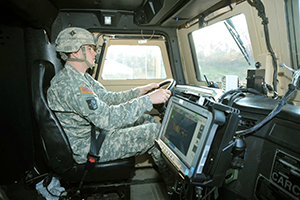Blazing an Unmanned Trail
By Brian Wise
Senior Test Officer, Unmanned Vehicle Division, Automotive Directorate

At ATEF, a Soldier operates a truck equipped with AMAS-BWASK to assess the situational awarness abd active safety capabilities of the system.
Adaptive cruise control, lane change alerts, assisted parking, emergency brake assist, collision avoidance, and pedestrian detection are becoming widespread on our highways, making the roads safer through technology. One automaker has publicly declared its vision that by 2020, nobody should be seriously injured or killed in one of their new cars. How can these technologies protect Soldiers on the battlefield? ATC, the Army’s premier automotive test center, is putting military versions of these systems to the test.
Active safety features and autonomous vehicle technology are focal points of the Autonomous Mobility Appliqué System (AMAS) test program at ATC. An “appliqué system” offers technology which complements and enhances an existing vehicle platform. Features of the AMAS By-Wire Active Safety Kit (BWASK) include lane departure warning/assist, forward and rear collision warning/assist, blind spot monitoring, adaptive cruise control, and hill hold and descent control. Using radar and camera input, AMAS-BWASK senses the surrounding conditions and obstacles and independently controls the throttle, applies the brakes, and provides assistive steering to the driver. For the Federal Highway Administration, ATC is also testing some vehicles for adaptive cruise control using inter-vehicular communication.
ATC’s Automotive Technology Evaluation Facility (ATEF) experts tested the AMAS-BWASK driver warning and assist functions using four heavy-duty Army tractor trucks and two Army flatbed semitrailers. The test crew used plastic vehicle targets with metallic enhancements and robotic devices to represent pedestrians, vehicles, and traffic. ATEF drivers, data collectors, mechanics, technicians, and engineers first tested the vehicles equipped with AMAS-BWASK in various scenarios to gather system characteristics data and identify any safety hazards. Once all safety concerns were rectified, system demonstrations were performed by five U.S. Army Soldiers. The Soldiers provided valuable feedback for future system development.
The test proceedings culminated with a VIP event held at the ATEF Paved Wide Section and attended by representatives of various Army Acquisition organizations. The test sponsor, U.S. Army Tank Automotive Research, Development and Engineering Center, ATC leadership, and test personnel oversaw the Soldier demonstrations of the vehicles equipped with AMAS-BWASK, including a ride-along portion. Along with tractor trucks and semitrailers, the U.S. Army Armament Research, Development and Engineering Center made available an autonomous Light Capability Rough Terrain Forklift and a Rough Terrain Container Handler with container alignment assist to demonstrate a more complete logistic scenario. The forklift and container handler were used to load the trailers being pulled by the tractors.
The goal of the AMAS test program, to save lives by preventing accidents and removing Soldiers from harm’s way, goes hand in hand with reduced equipment damage and increased efficiency in logistics, manpower, and fuel. Future AMAS development will include such advanced features as leader/follower and autonomous convoy operations.
You are now leaving www.atc.army.mil and entering another site. You will automatically be forwarded to the target page within five seconds.
